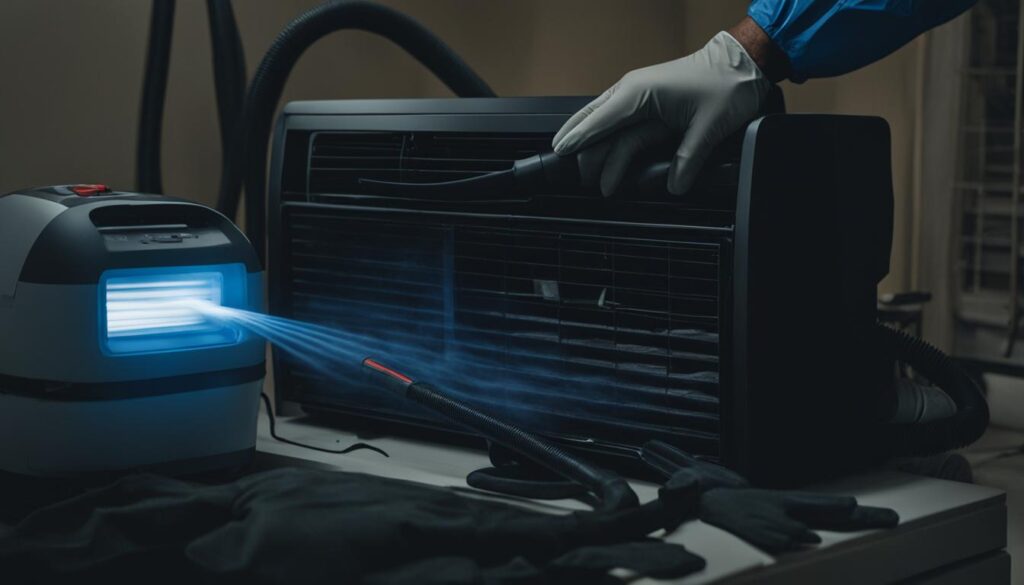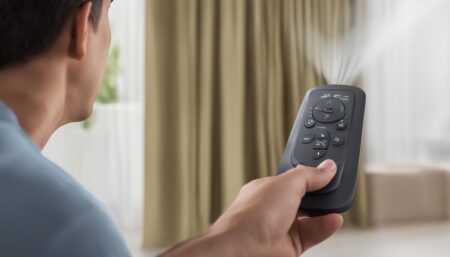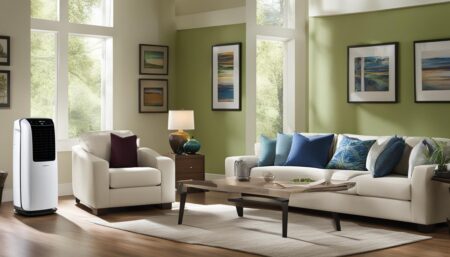Cleaning your portable air conditioner is essential for maintaining its efficiency and ensuring your family’s safety. Regular cleaning not only helps your AC unit work more efficiently but also saves electricity. In this comprehensive guide, we will walk you through the step-by-step process of cleaning and maintaining your portable air conditioner so that you can stay cool and comfortable all summer long.
Key Takeaways:
- Regularly clean and maintain your portable air conditioner to ensure optimal performance.
- Prepare your AC unit for cleaning by unplugging it and gathering the necessary tools.
- Drain the water from your portable air conditioner to prevent overflow and improve efficiency.
- Clean or replace the air filters to maintain proper airflow and prevent blockage.
- Check and clean the coils of your AC unit to ensure efficient cooling.
Prepare Your Portable Air Conditioner for Cleaning
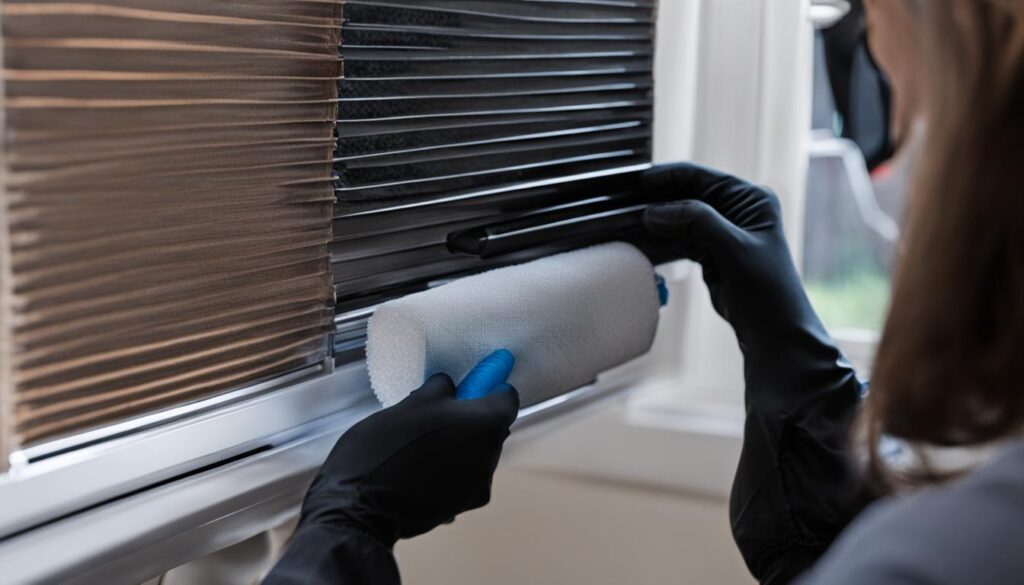
Before cleaning your portable air conditioner, it’s important to properly prepare the unit. Follow these steps to ensure a safe and effective cleaning process:
- Unplug the Unit: Start by unplugging the portable air conditioner from the power source. This will prevent any potential electrical accidents during the cleaning process.
- Secure Placement: Place the unit on a solid surface to avoid any water leaks or damage to your floors. Ensure there is enough space around the unit for easy access during cleaning.
- Gather Cleaning Tools: Arm yourself with the necessary tools for cleaning your portable AC unit. These may include a screwdriver, damp cleaning cloth, bucket or shallow pan, and a clean air filter if needed.
- Disassemble the AC Unit: Unscrew the panels at the back of the portable air conditioner to access the inner components. This will allow for a thorough and comprehensive cleaning process.
By properly following these steps, you’ll be ready to tackle the cleaning process and ensure optimal performance from your portable air conditioner.
Drain the Water from Your Portable Air Conditioner
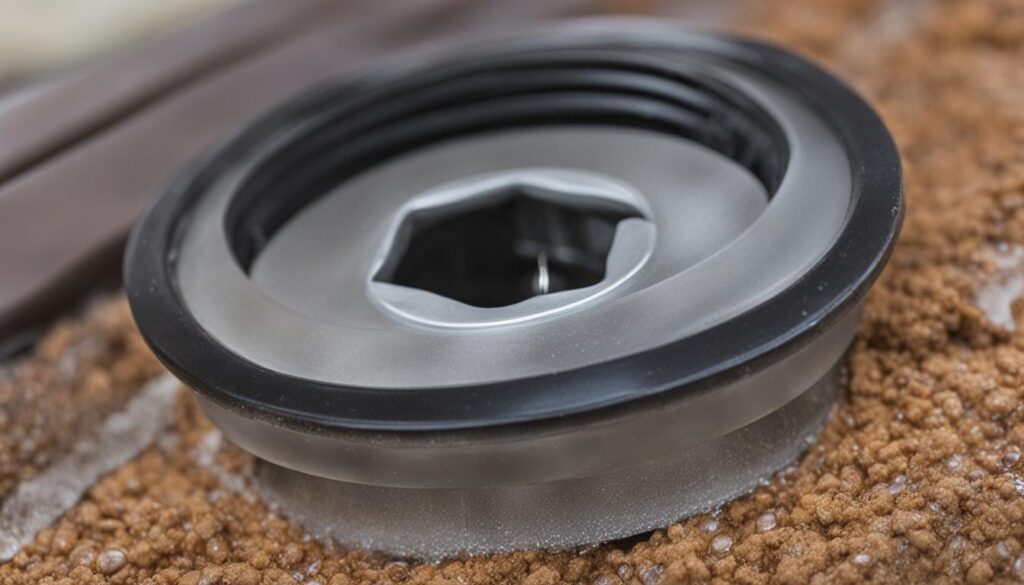
Portable air conditioners collect water from the air, which needs to be drained regularly. If the accumulated water is not removed, it can cause the air conditioner to malfunction and lead to water leakage.
Here’s how you can effectively drain the water from your portable air conditioner:
- Locate the drain on the back of your unit. It is usually a small hole with a removable plug or cap.
- Place a bucket or shallow tray underneath the drain to collect the water. Ensure that the container is large enough to hold the water without overflowing.
- Remove the plug or cap from the drain carefully, making sure not to lose it.
- Allow the water to drain out completely into the bucket or tray. Be patient, as it may take some time to empty the water tank.
- Once all the water has drained, replace the plug or cap securely to prevent any air or moisture leaks.
Pro Tip: If you have a continuous drainage option, you can connect a hose to the drain to enable automatic water drainage. Make sure the other end of the hose is positioned near a suitable drainage area, such as a floor drain or an outdoor space away from your home’s foundation.
Emptying the water tank regularly prevents water overflow in your portable air conditioner and helps improve its overall performance. It’s a simple step that ensures your AC unit operates efficiently and provides consistent cooling throughout the hot summer months.
Cleaning and Maintenance Benefits
“Draining the water from your portable air conditioner is an essential part of its regular cleaning and maintenance routine. By removing the accumulated water, you can prevent potential water leakage and ensure optimal functioning of your AC unit. Regular maintenance not only extends the lifespan of your portable air conditioner but also saves you from expensive repairs.”
Recommended Drainage Frequency
The frequency of draining the water depends on the humidity level and usage of your portable air conditioner. As a general guideline, it is recommended to check and empty the water tank at least once a week during periods of heavy usage or high humidity. However, if you live in a particularly humid climate or use the AC unit frequently, you might need to drain the water more frequently.
| Usage Frequency | Drainage Frequency |
|---|---|
| Occasional use or low humidity | Every 2-4 weeks |
| Daily use or moderate humidity | Every 1-2 weeks |
| Frequent use or high humidity | Once a week or more |
Clean and Replace the Air Filters
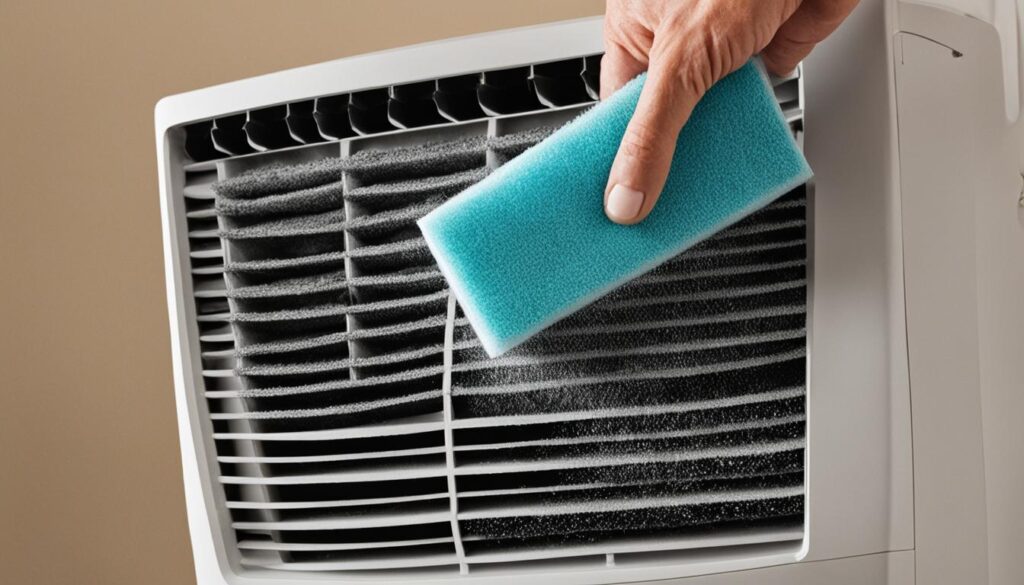
Keeping the air filters of your portable air conditioner clean is essential for maintaining its efficiency and ensuring optimal performance. Regular cleaning and replacement of air filters not only improve the air quality of your home but also help prolong the lifespan of your AC unit. Follow these steps to clean and replace the air filters of your portable air conditioner:
- Check the air filters at least twice a month to assess their cleanliness. Remove any visible dirt or debris that may be blocking the filters.
- If the filters are washable, begin by vacuuming them to remove loose dirt and dust.
- Next, prepare a warm, soapy water solution.
- Immerse the washable filters in the soapy water and gently agitate them to loosen any dirt buildup.
- Allow the filters to soak for 15-20 minutes.
- After soaking, rinse the filters thoroughly with clean water to remove all the soap residue.
- Let the filters dry completely before reinserting them into the air conditioner unit.
- If the filters are not washable, carefully remove them and replace them with new filters of the same size and type.
Regularly cleaning or replacing the air filters of your portable air conditioner helps maintain the unit’s efficiency by allowing unrestricted airflow and preventing dust and debris from clogging the system. This not only ensures optimal cooling but also saves energy and reduces strain on the AC unit. Make it a part of your routine maintenance to keep your portable air conditioner running smoothly.
Pro Tip: Set a reminder in your calendar or smartphone to check and clean the air filters of your portable air conditioner at regular intervals. This will help you stay on top of maintenance tasks and ensure long-term performance of your AC unit.
Comparison of Different Air Filter Types
| Filter Type | Features | Pros | Cons |
|---|---|---|---|
| Fiberglass Filters | Inexpensive | Widely available | Lower filtration efficiency |
| Pleated Filters | Greater surface area | Better filtration efficiency | Higher cost |
| HEPA Filters | High filtration efficiency | Removes microscopic particles | Expensive |
Choosing the right air filters for your portable air conditioner depends on various factors such as your budget, indoor air quality requirements, and specific needs. Consider the pros and cons of different filter types before making a decision.
Check the Coils of Your Portable Air Conditioner
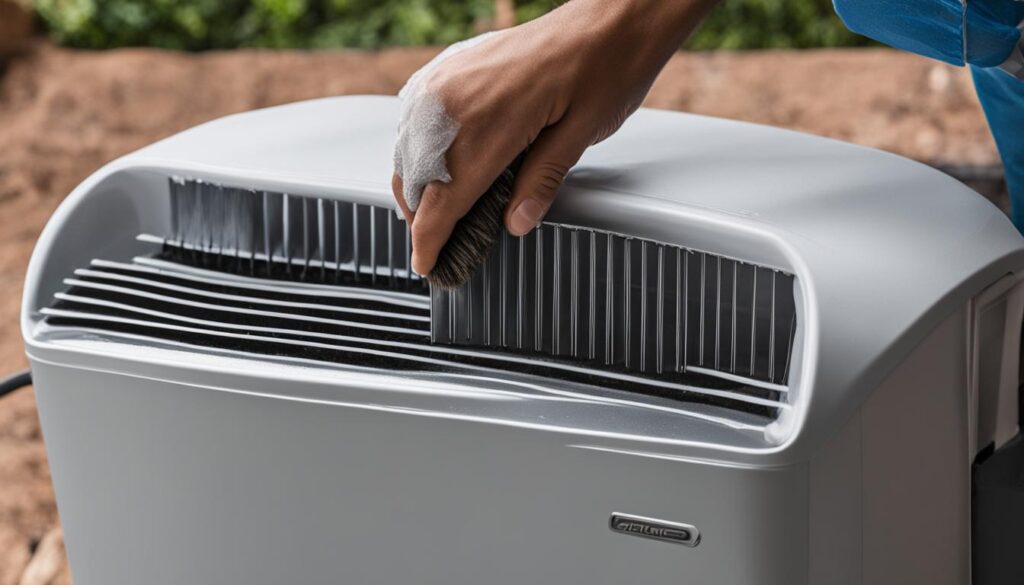
The coils of your portable air conditioner play a crucial role in its cooling function. Over time, these coils can accumulate dirt, dust, and debris, which can hinder the unit’s efficiency and potentially lead to expensive repairs. It is essential to regularly clean and maintain the coils to ensure optimal performance and prolong the lifespan of your air conditioner.
To clean the coils of your portable air conditioner, follow these simple steps:
- Ensure that the air conditioner is unplugged and turned off before starting the cleaning process.
- Using a damp cloth or a soft-bristled brush, gently remove any visible dirt or debris from the coils. Be careful not to apply excessive pressure, as this may damage the delicate fins.
- If there is stubborn dirt or grime on the coils, consider using a coil cleaning solution specifically designed for air conditioners. Follow the manufacturer’s instructions for safe and effective use.
- After cleaning, allow the coils to dry completely before reassembling the unit.
Regularly cleaning the coils of your portable air conditioner will help maintain their cleanliness and prevent the buildup of dirt and debris. This not only ensures the efficient cooling of your AC unit but also helps avoid costly repairs in the future. Incorporate coil cleaning as part of your regular maintenance routine to keep your portable air conditioner running smoothly.
Tidy Up the Exterior of Your Portable Air Conditioner
Now that you have removed the panels from your portable air conditioner, it’s time to clean the exterior. This step is essential to ensure optimal performance and prevent any dust or debris from clogging the vents. Follow these simple steps to tidy up the exterior of your AC unit:
- Take a soft, damp cloth and gently wipe down the entire surface of the air conditioner. Be thorough in your cleaning, paying close attention to the vents and any small spaces where dust may have accumulated.
- Ensure the cloth is damp, not wet, to avoid causing any damage to the unit. You can also use a mild cleaning solution if necessary, but make sure to read the manufacturer’s recommendations before applying any chemicals.
- Remember to carefully clean the vents, as they can easily gather dust and obstruct the airflow. Use a soft brush or cloth to remove any dirt or debris that may be stuck in the vents.
- Allow the exterior of the portable air conditioner to dry completely before reattaching the panels. This will help prevent moisture from getting trapped inside, which can lead to mold or other issues.
Routine cleaning of the exterior of your portable air conditioner is essential for maintaining its efficiency and prolonging its lifespan. By removing dust and debris from the vents and surface, you can ensure that your AC unit operates at its best, providing you with cool and clean air throughout the summer.
“Regular cleaning of the exterior of your portable air conditioner helps maintain its efficiency and prolong its lifespan. By removing dust and debris, you can ensure that your AC unit operates at its best, providing you with clean and cool air.”
Proper Storage of Your Portable Air Conditioner
When it’s time to store your portable air conditioner, it’s important to take the necessary steps to ensure its proper maintenance and longevity. Follow these guidelines for storing your unit:
- Drain the Water Tank: Before storage, make sure to drain any accumulated water from the tank. This prevents the formation of mold and mildew during the storage period. Locate the drain on the back of your portable AC unit and position a bucket or shallow tray underneath it. Allow the water to fully drain out.
- Clean or Replace the Filter: The filter plays a crucial role in maintaining the efficiency of your portable air conditioner. Clean it thoroughly or, if necessary, replace it before storing the unit. A clean filter ensures optimal performance when you use the air conditioner again in the future.
- Eliminate Excess Moisture: To prevent the growth of mold or mildew, it’s recommended to run the portable air conditioner in fan mode for 30 minutes to an hour before storage. This helps eliminate any excess moisture within the unit.
Once you’ve completed these steps, you can store your portable air conditioner in its original packaging, if available. Make sure to choose a clean and dry storage space, away from humidity and extreme temperatures.
Tips for Proper Storage
Here are some additional tips to ensure the safe and effective storage of your portable air conditioner:
- Keep the unit in an upright position to prevent any oil leakage from the compressor.
- Store the AC unit in a secure location where it won’t be subject to potential damage or accidental bumps.
- Inspect the power cord for any damages or frayed wires. If you notice any issues, have it repaired before storing the unit.
- Label the storage space with the name and model of the portable air conditioner for easy identification.
By following these storage guidelines, you can ensure that your portable air conditioner remains in optimal condition during its period of non-use.
| Benefits of Proper Storage | Tips for Effective Storage |
|---|---|
| 1. Prevents Mold and Mildew: Draining the water tank and eliminating excess moisture helps prevent the growth of mold and mildew, ensuring a clean and healthy unit. | 1. Choose a Dry Storage Space: Opt for a clean and dry storage area to prevent moisture damage and maintain the integrity of the AC unit. |
| 2. Maintains Air Conditioner Performance: Cleaning or replacing the filter before storage ensures efficient performance when the unit is used again. | 2. Store in Upright Position: Storing the unit upright prevents oil leakage and potential damage to internal components. |
| 3. Prolongs Lifespan: Proper storage practices contribute to the longevity of your portable air conditioner, saving you money on repairs or replacements. | 3. Inspect and Repair: Before storing, inspect the power cord for any damages and have it repaired to avoid potential safety hazards. |
Conclusion
Regularly cleaning and maintaining your portable air conditioner is crucial for its efficient operation and extended lifespan. By following this DIY portable air conditioner cleaning guide, you can enjoy cooler air, lower electricity usage, and a safer environment for your family.
Proper maintenance ensures that your AC unit works at its best, providing you with the comfort you need during the hot summer months. Don’t forget to clean your portable air conditioner before the summer season begins to address any potential issues and ensure optimal performance.
By taking the time to clean and maintain your portable air conditioner, you can:
- Maximize the efficiency of your AC unit
- Save on energy costs
- Extend the lifespan of your portable air conditioner
- Ensure the safety of your family by preventing dust and debris buildup
Remember, proper maintenance is key to maintaining AC unit efficiency and longevity. With regular cleaning and care, you can enjoy a cool and comfortable home throughout the summer.
“Regular cleaning and maintenance of your portable air conditioner can significantly improve its efficiency and help extend its lifespan. Don’t overlook this essential step in keeping your home cool and comfortable.”
Additional Resources for Summer Comfort
If you’re in the market for a new portable air conditioner, check out sources like CNET for tips on finding the right one. Additionally, there are alternative cooling options such as window air conditioners that offer affordability. Explore more articles on staying comfortable during summer without central AC, including making your own AC unit and tips for extending the lifespan of window air conditioners.
Finding the Right Portable Air Conditioner
When it comes to finding the perfect portable air conditioner, it’s important to consider factors such as BTU (British Thermal Units) rating, energy efficiency, noise levels, and size. Websites like CNET provide comprehensive reviews and buying guides to help you make an informed decision. Whether you need a unit for a small bedroom or a larger living space, they offer recommendations for every requirement.
Alternative Cooling Options
If a portable air conditioner doesn’t fit your needs or budget, window air conditioners can be a great alternative. These units are affordable, easy to install, and provide effective cooling for single rooms. They come in different sizes and cooling capacities, allowing you to choose the best option for your space. Regular maintenance, such as cleaning the filters and ensuring proper insulation, can optimize their performance.
Tips for Window Air Conditioner Maintenance
- Check and clean the air filters regularly to prevent dust and debris buildup.
- Ensure proper insulation around the unit to minimize air leakage.
- Seal any gaps or cracks around the window frame to prevent cold air from escaping.
- Consider using a window insulation kit to improve energy efficiency.
- During colder months, remove the unit or cover it securely to protect it from the elements.
“Window air conditioners can be a cost-effective cooling solution for individual rooms, making them a popular alternative to portable units.”
With these alternative cooling options and maintenance tips, you can stay cool and comfortable during the summer without relying solely on central air conditioning. Exploring different options allows you to find the best fit for your specific needs and budget.
| Pros of Portable Air Conditioners | Cons of Portable Air Conditioners |
|---|---|
| Easy installation and mobility | Higher energy consumption compared to other options |
| No permanent installation required | Noisy operation, especially for larger units |
| Ability to cool different rooms | Requires space for venting hot air |
| Flexibility to move the unit around | May not be as effective in extremely hot climates |
Recommended Portable Air Conditioners of 2022
When it comes to finding the best portable air conditioner for your needs, it’s always helpful to turn to reputable sources for recommendations. CNET, a trusted technology and consumer electronics website, has compiled a list of the top portable AC units of 2022. These recommendations can guide you in making an informed decision when purchasing a new AC unit for your home.
With CNET’s expertise and thorough testing, you can trust that their recommendations are based on performance, features, and user satisfaction. Their list includes a variety of options, ranging from compact and budget-friendly units to high-performing, feature-rich models. Whether you need a portable AC unit for a small room, a large living area, or something in between, CNET’s recommendations have got you covered.
By choosing one of CNET’s best portable air conditioners of 2022, you can enjoy the convenience of mobile cooling, without the need for permanent installation. These units offer efficient cooling, adjustable settings, and portable designs, making them ideal for apartments, offices, and other spaces where traditional central air conditioning may not be available or practical.



